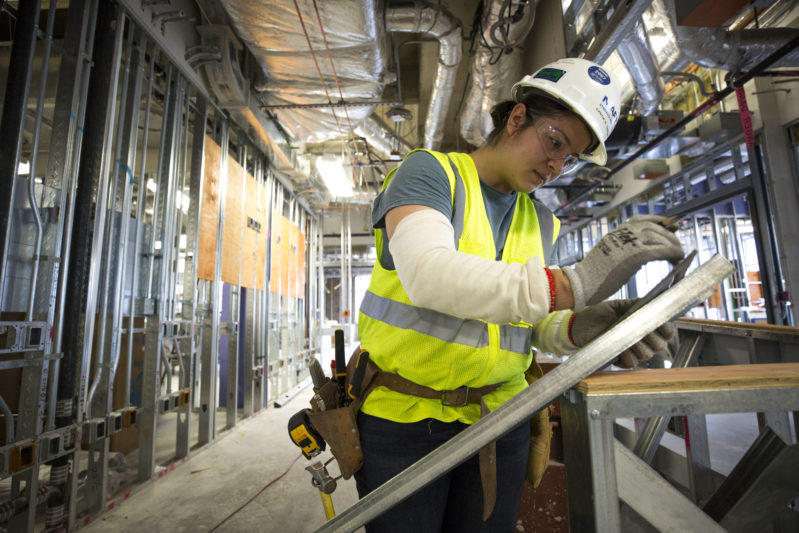The following article was authored by Construction Career Collaborative Executive Director Chuck Gremillion.
 Nearly ten years ago, a group of leaders in the Houston commercial construction industry met to discuss its biggest future challenge, an aging and diminishing craft workforce. Baby Boomers were (and still are) reaching retirement age at the rate of 10,000 people each day, and the construction trades were not attracting young talent to replenish them. In short, what was once a healthy, sustainable craft workforce was no longer. The construction industry was losing the battle for talent to other industries whose workforce practices were perceived as providing better opportunities and a brighter future.
Nearly ten years ago, a group of leaders in the Houston commercial construction industry met to discuss its biggest future challenge, an aging and diminishing craft workforce. Baby Boomers were (and still are) reaching retirement age at the rate of 10,000 people each day, and the construction trades were not attracting young talent to replenish them. In short, what was once a healthy, sustainable craft workforce was no longer. The construction industry was losing the battle for talent to other industries whose workforce practices were perceived as providing better opportunities and a brighter future.
When these leaders examined the underlying cause of the issue, they realized that the human resources practices that originally created a skilled and sustainable craft workforce had largely vanished. Many companies had severed the employer-employee relationship, which eliminated traditional employee benefits as well as Social Security, Medicare and state and federal unemployment tax benefits. Craft workers were being paid as independent subcontractors. The provision of skills training had ceased, and as a result, construction career paths had all but ended.
From this meeting sprung the idea of the Construction Career Collaborative (C3), a diverse organization of owners (those who purchase construction services), general contractors, specialty contractors, industry trade organizations and design professionals whose goal is to create a safe, skilled and sustainable craft workforce. Foundational to this organization are three core principles – proper human resources practices, the pursuit, development and adoption of the best construction-industry safety standards and skills training linked to construction career paths.
Fast forward to today and C3 has made significant strides forward in all three of these areas of focus. Much of the industry has recognized the importance of the employer-employee relationship and how it relates to the development of its craft workforce. Rarely will a company invest in the training of a craft worker who is not its employee. These companies also recognize that they cannot compete for talent in a job market with unemployment rates below 4% without the competitive human resources practices that C3 prescribes.
These competitive practices include safety standards that enable craft workers to return home safely at the end of each work day. C3 requires that each craft worker on a C3 jobsite earn an OSHA 10 credential and their supervisors earn an OSHA 30 credential. In fact, we believe that C3 projects may be the only ones in the USA, in the commercial construction industry, where all workers meet this standard. Additionally, in just 29 months, there have been 94,746 attendees in the C3 Safety Refresher Training, which consists of 12 training modules, delivered once per month, and specific to commercial construction. This training and certification translates into a safer working environment that is exemplified by an aggregate Total Recordable Incident Rate (TRIR)on C3 projects of .86, 300% better than the national average for all non-residential construction in this country as measured by the United States Bureau of Labor Statistics (BLS).
Finally, and maybe the most critical measure of C3’s progress towards a goal of building a safe, skilled and sustainable craft workforce, is the rapidly growing number of companies investing in and developing their craft training programs. These companies know that trained, skilled workers are not only safer workers, but they produce high-quality work, and more of it, in less time with less rework and less supervision resulting in higher employee morale, lower employee turnover, growing sales revenue and higher profit margins. To date, 173 companies, both general contractors and specialty contractors, have enrolled in the C3 Craft Training Endorsement Program, and 60 of these companies have earned a coveted C3 Craft Training Endorsement. In fact, we believe that there is a strong possibility that 100 companies will achieve an endorsement by year end.
It should not go without mention that the C3 training team is consulting with many of the above-referenced companies to guide them through the development of their respective craft training initiatives. This is a critical component of the C3 formula because we recognize that a large number of construction companies do not have an HR/Training Department. As a result, they may not have the expertise or “know how” to develop and deliver craft training. C3 does, and we are sharing that knowledge with C3 Accredited Employers, free of charge!
In closing, some numbers that illustrate C3’s growing success and influence within the commercial construction industry in the Houston region since its inception:
- 14 Owners, several of which have had multiple C3 projects
- 39 C3 Projects with total construction value exceeding $2.5B
- 253 Accredited Employers
- 26 General Contractors
- 227 Specialty Contractors
- 173 companies enrolled in the C3 Craft Training Endorsement Program
- 60 companies that have earned a C3 Craft Training Endorsement
- 23,891 craft workers enrolled in the C3 Training Database
- Aggregate Total Recordable Incident Rate for all C3 Projects of .86
- 94,746 attendees in C3 Safety Refresher Training
If you and your company have not yet engaged with C3, contact us. Just as we are helping other construction companies, we can help yours too. Getting involved with C3 could prove to be one of the wisest business decisions you have ever made.
Key C3 Contacts
Diane Aguilar
Operations Administrator
[email protected]
(713)999-1324
Angela Robbins
Associate Director – People Development, Compliance and Operations
[email protected]
(713)999-1032
Chuck Gremillion
Executive Director
[email protected]
713)999-1218

